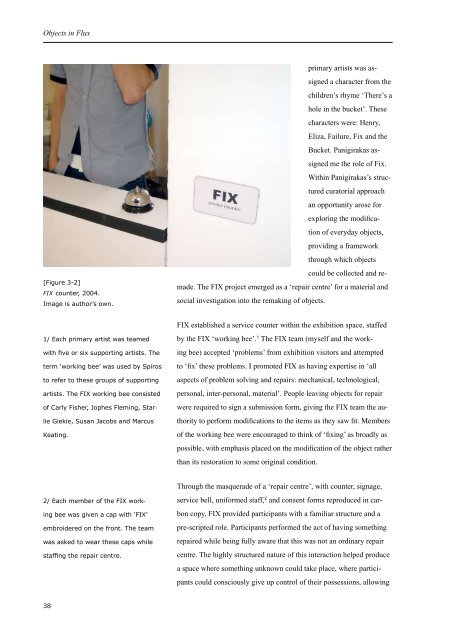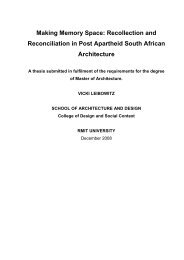Objects in Flux - RMIT Research Repository - RMIT University
Objects in Flux - RMIT Research Repository - RMIT University
Objects in Flux - RMIT Research Repository - RMIT University
You also want an ePaper? Increase the reach of your titles
YUMPU automatically turns print PDFs into web optimized ePapers that Google loves.
<strong>Objects</strong> <strong>in</strong> <strong>Flux</strong><br />
[Figure 3-2]<br />
FIX counter, 2004.<br />
Image is author’s own.<br />
1/ Each primary artist was teamed<br />
with five or six support<strong>in</strong>g artists. The<br />
term ‘work<strong>in</strong>g bee’ was used by Spiros<br />
to refer to these groups of support<strong>in</strong>g<br />
artists. The FIX work<strong>in</strong>g bee consisted<br />
of Carly Fisher, Jophes Flem<strong>in</strong>g, Star-<br />
lie Giekie, Susan Jacobs and Marcus<br />
Keat<strong>in</strong>g.<br />
2/ Each member of the FIX work-<br />
<strong>in</strong>g bee was given a cap with ‘FIX’<br />
embroidered on the front. The team<br />
was asked to wear these caps while<br />
staff<strong>in</strong>g the repair centre.<br />
38<br />
primary artists was assigned<br />
a character from the<br />
children’s rhyme ‘There’s a<br />
hole <strong>in</strong> the bucket’. These<br />
characters were: Henry,<br />
Eliza, Failure, Fix and the<br />
Bucket. Panigirakas assigned<br />
me the role of Fix.<br />
With<strong>in</strong> Panigirakas’s structured<br />
curatorial approach<br />
an opportunity arose for<br />
explor<strong>in</strong>g the modification<br />
of everyday objects,<br />
provid<strong>in</strong>g a framework<br />
through which objects<br />
could be collected and remade.<br />
The FIX project emerged as a ‘repair centre’ for a material and<br />
social <strong>in</strong>vestigation <strong>in</strong>to the remak<strong>in</strong>g of objects.<br />
FIX established a service counter with<strong>in</strong> the exhibition space, staffed<br />
by the FIX ‘work<strong>in</strong>g bee’. 1 The FIX team (myself and the work<strong>in</strong>g<br />
bee) accepted ‘problems’ from exhibition visitors and attempted<br />
to ‘fix’ these problems. I promoted FIX as hav<strong>in</strong>g expertise <strong>in</strong> ‘all<br />
aspects of problem solv<strong>in</strong>g and repairs: mechanical, technological,<br />
personal, <strong>in</strong>ter-personal, material’. People leav<strong>in</strong>g objects for repair<br />
were required to sign a submission form, giv<strong>in</strong>g the FIX team the authority<br />
to perform modifications to the items as they saw fit. Members<br />
of the work<strong>in</strong>g bee were encouraged to th<strong>in</strong>k of ‘fix<strong>in</strong>g’ as broadly as<br />
possible, with emphasis placed on the modification of the object rather<br />
than its restoration to some orig<strong>in</strong>al condition.<br />
Through the masquerade of a ‘repair centre’, with counter, signage,<br />
service bell, uniformed staff, 2 and consent forms reproduced <strong>in</strong> carbon<br />
copy, FIX provided participants with a familiar structure and a<br />
pre-scripted role. Participants performed the act of hav<strong>in</strong>g someth<strong>in</strong>g<br />
repaired while be<strong>in</strong>g fully aware that this was not an ord<strong>in</strong>ary repair<br />
centre. The highly structured nature of this <strong>in</strong>teraction helped produce<br />
a space where someth<strong>in</strong>g unknown could take place, where participants<br />
could consciously give up control of their possessions, allow<strong>in</strong>g
















